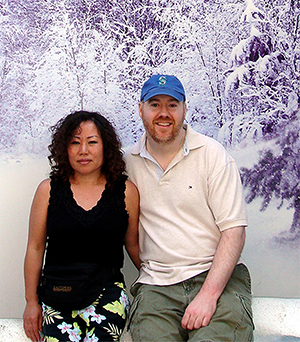
 Photography Tips for Everyday Moments
Photography Tips for Everyday Moments
The most extraordinary beauty is often found in ordinary moments. In this series, William Stanek helps you see the world through a new lens, transforming everyday experiences into stunning photographic memories.

Transform your life with practical wisdom. Discover William Stanek's 'Living Well' series—your guide to a balanced and fulfilling life.
Discover William Stanek's Exclusive Art Collection
Explore and purchase the stunning art featured on this site. Own a piece of William Stanek's unique and captivating artwork today!
(May 8, 2025) Photographing Connections: Capturing Relationships and Interactions
Photographing people is not just about capturing their likeness—it’s about telling the story of their relationships and interactions. Whether you’re photographing family, friends, or even strangers, capturing the connections between people adds depth and meaning to your images, transforming them into something more than just a moment frozen in time. Here, we’ll explore how to capture relationships and interactions in your photography, focusing on the techniques that will help you convey the emotions and stories behind those connections.
Introduction: The Power of Human Connection
At the heart of many powerful photographs is the connection between people. Whether it’s the bond between a parent and child, the camaraderie among friends, or the unspoken understanding between strangers, these connections are what give a photo its emotional weight. As a photographer, your challenge is to capture these relationships in a way that feels authentic and meaningful, allowing viewers to see and feel the connection as if they were there.
Photographing connections is about more than just composition and technical skill—it’s about empathy, observation, and the ability to recognize and capture the subtle interactions that define human relationships. In this article, we’ll delve into the techniques that will help you photograph these connections, creating images that tell a deeper, more resonant story.
Candid vs. Posed: The Art of Capturing Authentic Moments vs. Setting Up Scenes
One of the first decisions you’ll need to make when photographing connections is whether to capture candid moments or to set up a posed scene. Each approach has its own strengths and can be used to achieve different effects, depending on the story you want to tell.
Capturing Candid Moments: Candid photography is all about capturing people in natural, unposed situations, allowing their interactions to unfold organically. This approach is ideal for photographing genuine connections, as it allows you to capture emotions and relationships as they naturally occur, without the artificiality that can sometimes come with posed shots.
- Tips for Capturing Candid Moments:
- Blend into the Background: To capture candid moments, try to be as unobtrusive as possible. Use a longer lens to shoot from a distance, allowing your subjects to forget about the camera and interact naturally.
- Be Patient: Candid photography requires patience. Wait for the right moment to capture an interaction or expression that tells a story. The best candid shots often come from waiting and observing rather than from taking lots of shots in quick succession.
- Look for Unscripted Moments: The beauty of candid photography lies in its spontaneity. Look for the small, unscripted moments—a shared glance, a spontaneous laugh, a gentle touch—that reveal the true nature of the connection between people.
Setting Up Posed Scenes: While candid photography captures interactions as they happen, posed photography allows you to create a scene that emphasizes the connection between people. This approach gives you more control over the composition, lighting, and overall mood of the image, making it easier to highlight specific aspects of the relationship.
- Tips for Setting Up Posed Scenes:
- Guide, Don’t Direct: When posing people, aim to guide them rather than direct them. Instead of giving rigid instructions, suggest actions or scenarios that might evoke genuine emotions, such as asking a couple to share a private joke or encouraging a family to hug each other tightly. This helps create a more natural, relaxed atmosphere, even in a posed setting.
- Focus on Interaction: In posed scenes, encourage your subjects to interact with each other rather than just looking at the camera. This could mean holding hands, looking into each other’s eyes, or simply standing close together. These interactions help convey the connection between your subjects, making the posed shot feel more authentic.
- Use Props or Settings: Props or specific settings can add context to a posed scene, enhancing the story you’re trying to tell. For example, photographing a couple in a meaningful location or using an object that holds sentimental value can add layers to the image, deepening the sense of connection.
Pro Tip: Whether shooting candidly or posing your subjects, always be mindful of the emotions and dynamics at play. The best images are those that capture something genuine, so strive to create a comfortable, trusting environment where your subjects feel at ease.
Exercise: Spend time photographing people in both candid and posed situations. For candid shots, focus on capturing genuine interactions without directing your subjects. For posed shots, guide your subjects into natural interactions and emotions. Compare the results and reflect on how each approach influences the connection and story conveyed in the images.
Emphasizing Connection: Framing and Composition Techniques to Highlight Relationships
The way you frame and compose your shot can greatly influence how the connection between people is perceived. By using thoughtful composition techniques, you can draw attention to the relationships in your images, emphasizing the bonds and interactions that define them.
Using Close-Ups to Capture Intimacy: Close-up shots can be incredibly powerful in conveying the intimacy of a relationship. By focusing on details—such as hands holding, a tearful eye, or a shared smile—you can highlight the emotional connection between your subjects. Close-ups remove distractions from the background, allowing the viewer to focus entirely on the interaction.
Creating Balance and Symmetry: Balance and symmetry in composition can be used to symbolize harmony and equality in a relationship. Position your subjects in a way that creates a sense of equilibrium in the frame—whether it’s a couple standing side by side, friends sitting together, or a family group shot. Symmetrical compositions can convey a sense of unity and togetherness.
Using Leading Lines: Leading lines guide the viewer’s eye through the image, often directing attention to the focal point of the connection. In photographs of people, these lines could be the natural lines of a path, the curve of an arm, or the way a gaze directs attention to another person in the frame. Use leading lines to emphasize the relationship between your subjects and to create a visual connection between them.
Playing with Perspective: The perspective from which you shoot can alter the way a connection is perceived. Shooting from above can create a sense of intimacy, as if you’re observing a private moment, while shooting from below can add a sense of grandeur or importance to the relationship. Consider how different angles and perspectives can change the mood and message of the image.
Incorporating Negative Space: Negative space—the empty areas around your subject—can be used to emphasize the connection between people by isolating them from the background. This technique can create a sense of focus and simplicity, highlighting the relationship as the central element of the image.
Pro Tip: When composing your shot, think about how the placement of your subjects, the use of lines, and the balance of the frame can enhance the connection you’re trying to capture. Every element of the composition should work towards highlighting the relationship and the emotions behind it.
Exercise: Practice photographing connections by experimenting with different framing and composition techniques. Try using close-ups to capture intimacy, leading lines to guide the viewer’s eye, and negative space to isolate the connection. Reflect on how these compositional choices influence the way the relationship is perceived in the final image.
Emotion in Photography: Capturing the Emotions That Define Human Interactions
Emotion is at the heart of any connection between people, and capturing these emotions in your photography is key to creating images that resonate with viewers. Whether it’s joy, sadness, love, or tension, the emotions that define human interactions are what make your photos powerful and memorable.
Recognizing Genuine Emotion: The first step in capturing emotion is recognizing it when it happens. Pay close attention to your subjects—their facial expressions, body language, and the way they interact with each other. Genuine emotion is often subtle, so be ready to capture it as it unfolds. This might mean photographing a quiet moment of reflection, the burst of laughter between friends, or the tenderness in a couple’s gaze.
Using Light to Enhance Emotion: Lighting plays a significant role in conveying emotion. Soft, diffused light can create a calm, gentle atmosphere, perfect for capturing intimate or tender moments. In contrast, harsh, directional light can add drama and intensity, emphasizing stronger emotions like anger or passion. Consider how the quality and direction of light can enhance the emotional tone of your image.
Capturing Movement and Gesture: Human interactions are often defined by movement and gesture—a hand reaching out, a quick embrace, a comforting touch. These movements can be fleeting, so be prepared to capture them as they happen. Use a fast shutter speed to freeze these moments, or slow down your shutter speed to convey the fluidity and motion of the interaction.
Focusing on the Eyes: The eyes are often said to be the windows to the soul, and they play a crucial role in conveying emotion. When photographing people, focus on their eyes to capture the depth of their emotions. Whether it’s the intensity of a stare, the vulnerability of a tear, or the joy of a smile, the eyes can communicate more than words ever could.
Telling a Story Through Emotion: Emotion is a powerful storytelling tool in photography. Use the emotions you capture to tell a deeper story about the relationship between your subjects. For example, a series of images that show a range of emotions—from joy to sadness to reconciliation—can tell a narrative about the ups and downs of a relationship, making your photos more engaging and meaningful.
Pro Tip: Don’t be afraid to get close and capture the raw, unfiltered emotions of your subjects. The most powerful images are often those that reveal vulnerability and authenticity, so create an environment where your subjects feel comfortable expressing their true emotions.
Exercise: Focus on capturing the emotions that define a relationship or interaction. Pay attention to the subtle cues—facial expressions, body language, gestures—and experiment with different lighting and perspectives to enhance the emotional impact of your images. Create a series of photos that tell a story through the emotions you capture, and reflect on how these emotions bring the connection to life.
Connecting Through the Lens: Capturing Relationships and Interactions
Photographing connections between people is about more than just documenting a moment—it’s about telling a story, capturing emotions, and highlighting the relationships that shape our lives. By focusing on the interactions, emotions, and connections that define human relationships, you can create images that resonate deeply with viewers, revealing the beauty and complexity of the human experience.
Building Trust with Your Subjects: One of the most important aspects of photographing connections is building trust with your subjects. The more comfortable and at ease they feel, the more natural and authentic their interactions will be. Take the time to get to know your subjects, listen to their stories, and create a space where they feel safe to be themselves.
Pro Tip: Always approach your subjects with empathy and respect, especially when capturing intimate or emotional moments. The trust you build with your subjects will be reflected in the authenticity and depth of the images you create.
Exercise: Choose a pair or group of people and spend time photographing their interactions and relationships. Focus on capturing the emotions and connections that define their bond, whether through candid moments, posed scenes, or a combination of both. Reflect on how the trust and rapport you build with your subjects influence the authenticity and impact of the images.
Conclusion: The Power of Capturing Connections
The connections between people are at the heart of many of the most powerful photographs. By focusing on relationships and interactions, you can create images that go beyond mere representation, revealing the emotions, stories, and bonds that make us human. Whether you’re capturing candid moments or setting up posed scenes, the goal is to highlight the connections that define our lives, creating images that resonate on a deeper, more emotional level.
As you continue to explore the art of photographing connections, remember that your role as a photographer is not just to capture what you see, but to convey what you feel. The more you can connect with your subjects and understand their relationships, the more powerful and meaningful your images will be.
Share your photos that capture human connections with us on Instagram using #CapturedConnections. We’d love to see how you’re telling the stories of relationships and interactions through your photography.

Join William at the crossroads of technology, business, and leadership, where true influence isn't about titles - it's about inspiring action, driving change, and guiding others with integrity. Discover how authentic leadership can transform not just careers, but entire industries.
Bring Inspiration Home
Enhance your space with William Stanek's evocative art. Each piece is crafted to inspire and uplift your everyday life.

Support The Lights of Paris by Robert Stanek, William Stanek's pen name! Through vivid historical detail and deeply moving character stories, Robert takes readers on an unforgettable journey through one of history’s most transformative times.
















